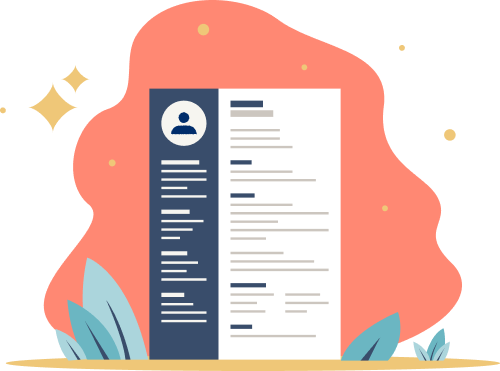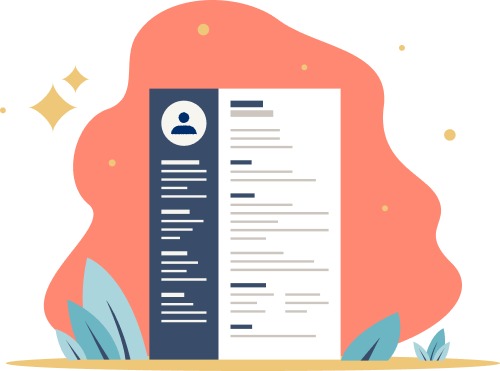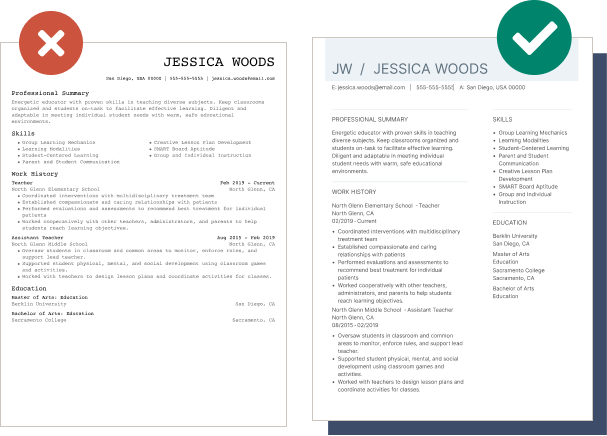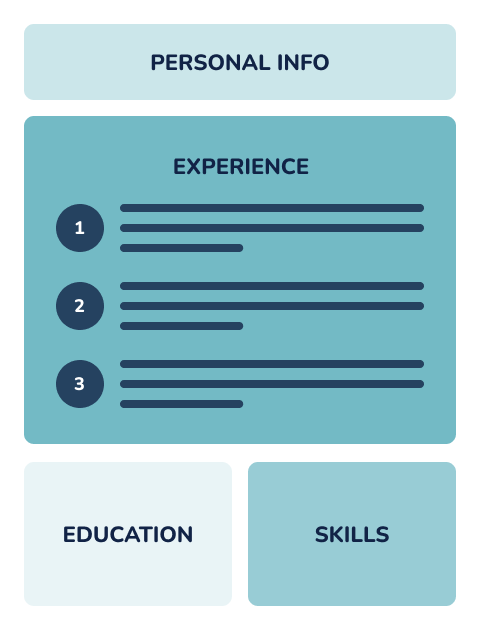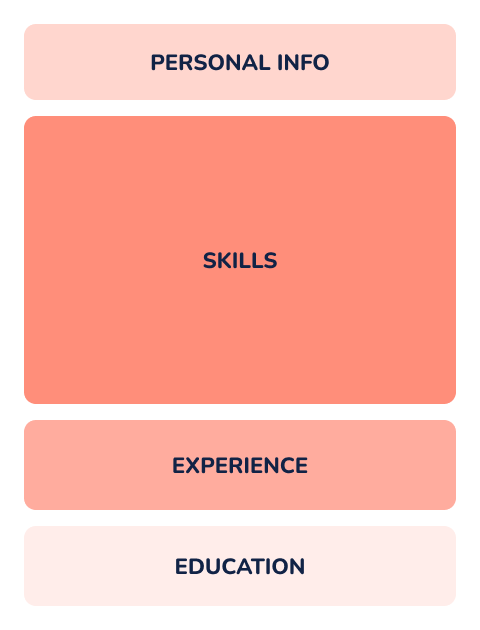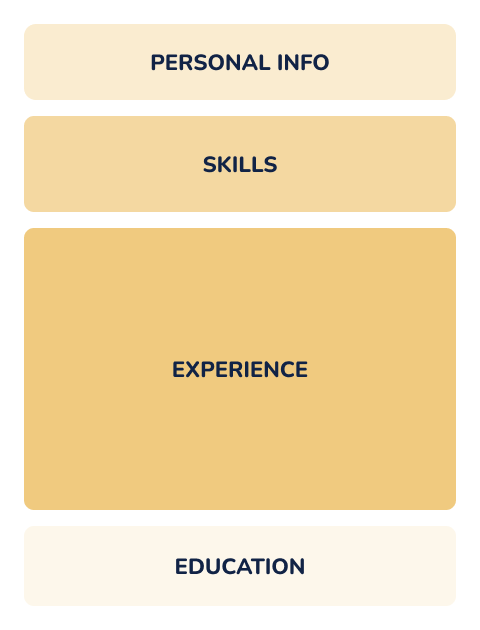Our customers have been hired at: *Foot Note
Creating a well-crafted resume doesn’t have to be complicated. Simply start with the basics by outlining your credentials. A resume outline can help build a customizable resume faster. You can use it as a framework for multiple applications and keep it handy to rebuild your resume. In case you’re wondering, “What is a resume outline?” and “How do you build a professional resume outline?”, you have come to the right place.
In this guide, you’ll find:
- A resume outline definition
- Template examples to build your resume outline
- Information to include in your resume outline
Our 800+ resume examples show how a well-made resume looks. Use them to create the best resume outline and build a professional resume for your next application.
What is a Resume Outline?
A resume outline is the framework of your qualifications. It is a professional document with all the main sections of a resume, plus any optional additional sections and all the possible information you could include in each resume section. Use a resume outline as a blueprint to customize your resume by picking and choosing what is relevant to each application.
The outline of a resume builds/creates the foundation for your content and helps you determine which experience and skills to include according to the employer’s needs and what you bring to the table.
Why Use a Resume Outline
You’re probably wondering why create a resume outline if you’re about to work on a resume. Doesn’t it create more work? Well, no. A resume outline helps you discern what information to include. It’s like writing a shopping list before an important dinner. You want to make sure you have all the necessary ingredients and supplies to make it a successful event while avoiding a surplus of items.
Once you are ready to start working on your resume, your resume outline will give you the foundation to create a professional, effective resume.
When to Use a Resume Outline
You can use a resume outline to help your resume writing process at any time. However, there are three instances where an outline for a resume will make the writing process easier and faster.
When you’re starting your career — If this is your first time building a resume, a resume outline can help you decide what to include and assess the skills that matter for the role.
When you’re changing industries — Reassessing your skills and qualifications to fit in a new role is easier when you have all the information in front of you. A resume outline will help you assess what you have to offer and organize it in your favor.
When you want to revamp your resume — If you’ve been unsuccessful in securing a role you want, build a resume outline to determine what to keep, what to toss and have an easier time creating a targeted resume.
How to Outline a Resume
A basic resume outline will have the five main sections of a resume, optional sections and all of your qualifications, education and abilities. Use this document to help you create multiple customized resumes for different job applications. Start with the basics.
Start your resume outline with the help of our resume templates. With 40+ professional resume templates, you’re bound to find an example to help you create the best resume outline.
1. Personal Information
A simple resume outline starts with personal information, which refers to your contact details, which include:
- Your name.
- A reachable phone number.
- Location where you’ll be working from.
- A professional email.
- Your website or portfolio.
- A professional networking profile, like LinkedIn or a membership organization.
2. Statement
This is your elevator pitch, where you include what the recruiter must learn about you. Depending on your years of experience, you can choose a summary statement or a resume objective.
A resume summary is a statement that summarizes your experience and what you bring to the table. To create one, include:
- A descriptive word.
- Your job title.
- Current experience level.
- Strongest job-relevant skills.
While the summary doesn’t have to follow that order, it must include all four parts. You can also add optional information like relevant achievements as well as certifications and licenses.
Use a resume objective if you’re starting your career and writing a resume with no experience or if you’re switching industries.
3. Professional experience
Your work experience section is listed in reverse-chronological order. It should include experience relevant to the position you’re seeking. Ensure to quantify your achievements using action verbs for a powerful section.
4. Education credentials
Hiring managers will ask for a minimum education requirement. List your highest level of education first and include the degree, name of the institution, year of graduation (if under a decade) and any honors, awards or recognition you received.
Still pursuing a degree? Include it with the expected graduation or completion date.
5. Skills
Skills will be present throughout your resume. A skills section will be dedicated to those abilities you want to highlight. While your focus will likely be in hard skills, don't forget to include soft skills, particularly interpersonal skills. The skills section supports up to 12 job-relevant skills.
6. Bonus sections
Employers will receive applicants with qualifications similar to yours. Including these optional sections can help you stand out from the candidate pool. For example:
- Certifications
- Volunteer work
- Hobbies relevant to your industry
Resume completed? Start writing your cover letter for a complete application. Our Cover Letter Builder can help you create an effective document with editable content suggestions and professional cover letter templates.
Resume Outline Examples
Still not sure where to start? These resume outlines examples will show you how to structure your information to catch the hiring manager’s attention according to where you want to go in your career.
Experienced Resume Outline
Your Name Professional summary Start with an adjective, your job title and years of experience. Move on to your strongest skill. Then, include one or two important achievements that highlight who you are as a candidate and what you could do for the employer. Approach this section as an elevator pitch and keep it under 5 sentences. Skills
Work experience Position | Month/Year to Month/Year
Position | Month/Year to Month/Year
Education Certifications
|
This is a good resume outline for an experienced candidate. It’ll help you keep consistent and job-specific information throughout your resume. A combination resume format will balance your skills and experience, helping you stand out from the candidate pool.
Entry-level Resume Outline
Your Name Career objective Candidates starting their career benefit should use a career objective. It explains why you’re seeking the role with that employer. Include your skills and an important quantifiable achievement from your education or work experience. Skills
Education
Work experience Position | Month/Year to Month/Year
Certifications
|
This resume outline is great for an entry level candidate, as it focuses on skills and education. Use this outline with a functional resume format to bring your strengths to the forefront.
Applying to your first job? Our guide on how to write a resume with no experience will show you how to write your perfect resume.
Managerial and Executive Resume Outline
Your Name Professional statement This is your elevator pitch. Use language that shows you are a managerial or executive candidate. Open up with an adjective, your role and years of experience. Include your strongest skill and important accomplishment to showcase what you bring to the table. Work experience Dates of employment
Dates of employment
Dates of employment
Skills
Education Degree Certifications
Organizations
|
This resume outline works great for managerial and executive candidates. It shows the importance of a longer career history. Using a chronological resume format is the best choice for executives, because it focuses on their extensive experience.
Make a resume with MyPerfectResume
Our Resume builder can help you write the perfect resume. Start Now!
Resources to Build Your Resume Outline
Ready to start building your resume outline? We have the resources you need to create an outstanding resume, with the latest trends and professional advice. Our guides on how to write each section of your resume will help you create a great professional document.
- Resume Objective Examples
- Resume Summary Examples
- Top Resume Skills
- How to Write an Effective ATS Resume
- Action Verbs for Your Resume
- What Are Resume Keywords and How Can They Help You
- An ATS Resume Checker for your Resume
- When and How to List References on a Resume
- Hobbies You Can List on Your Resume
- How cover letters empower your resume
Key Takeaways
A resume outline provides the foundation for a professional resume.
Use the outline of a resume as a blueprint or framework to create a targeted resume.
Include the main sections in your resume outline: contact information, experience, education, skills and a resume summary or objective with all your qualifications.
Adding bonus sections can help you stand out from the applicant pool. Only add those relevant to the position.
A resume outline can help you decide what to include in your cover letter.
FAQ
How to outline a resume?
To outline a resume, simply take a blank paper or document and:
- Add the five main sections of a resume.
- Write down the corresponding information under each resume section.
- Include additional sections, like certifications, languages, volunteering and so on.
- Use it as a blueprint to create multiple targeted resumes.
Think of your outline as a practice resume. You’re playing around with what to include in a resume that matters for the position you want.
Ready to build the real deal? Use our Resume Builder to input your information, choose a template, and select the best editable content suggestions for your professional resume.
What’s the difference between a resume outline and a resume template?
A resume outline is the bare bones of your resume. It encompasses all the information you could include in your resume before building a targeted resume for the position you want. A resume template is the placeholder. It is how you want to organize the content and layout of your resume. In other words, the outline is all about the content and the template is all about the design.
Do you outline what your job entails on a resume?
No. A resume includes the qualifications and experience you bring to a job. In a resume outline, you can include all your skills and use it as a master document to customize for each job application. Outline your quantified achievements from previous and current work experiences, hard and soft skills and education.
Our customers have been hired at:*Foot Note

